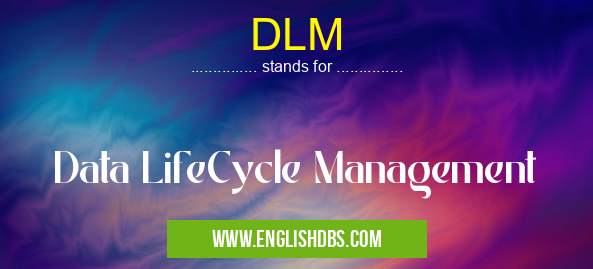What does DLM mean in MANAGEMENT
Data Life Cycle Management (DLM) is the practice of managing data from its point of creation or entry until it has reached its end-of-life stage. DLM encompasses a broad scope, and includes various components such as data storage, data security, archiving, and data disposal. It also serves as an effective means of providing visibility into the lifecycle of one's data assets. DLM is essential for businesses that need to keep critical business information secure and compliant with applicable regulations. By optimizing their DLM processes, businesses can ensure that their data remains secure while still being accessible to the necessary stakeholders in their organizations.

DLM meaning in Management in Business
DLM mostly used in an acronym Management in Category Business that means Data LifeCycle Management
Shorthand: DLM,
Full Form: Data LifeCycle Management
For more information of "Data LifeCycle Management", see the section below.
» Business » Management
What does DLM stand for?
DLM stands for Data Life Cycle Management.
What does DLM mean in Business?
In business, DLM is a critical component of any IT infrastructure that helps organizations manage important information over its entire lifespan. This involves controlling access to sensitive data and monitoring how it is stored and used throughout the organization. With effective use of DLM strategies, organizations can ensure that their information remains valid, up-to-date, and compliant with industry regulations and best practices. As such, having a strong length management strategy in place helps companies maintain consistent operational efficiency by ensuring that all stakeholders have access to accurate and complete data sets.
Essential Questions and Answers on Data LifeCycle Management in "BUSINESS»MANAGEMENT"
What is Data LifeCycle Management?
Data LifeCycle Management (DLM) is the practice of planning and managing the entire lifecycle of data from creation to deletion. It is an important part of information management, and involves considering all aspects of data throughout its life, including storage, access, archiving and retention.
What are the benefits of DLM?
DLM provides many benefits for organizations. It helps to ensure that data is accurate and up-to-date, as well as compliant with applicable laws and regulations. It also helps identify areas where improvements can be made, such as increasing security or reducing costs associated with excess storage. Additionally, it can help streamline operations by eliminating unnecessary processes.
How does DLM work?
DLM involves establishing a framework for managing data throughout its lifecycle. This includes creating rules and processes for when data should be created, updated, accessed, archived or deleted. The framework also outlines what data needs to be stored where and how long it should be retained for compliance purposes.
What types of data should be managed through DLM?
All types of digital information should be subject to a DLM process since it has value within an organization - this includes text documents, spreadsheets, images, audio files etc. In addition to digital formats, some physical records may also need to go through a similar process if they are expected to remain accessible in the long-term.
How is DLM different from traditional IT processes?
Traditional IT processes generally involve operating systems or environments such as servers or networks which need maintenance or version control updates; whereas DLM focuses on how data itself changes over time rather than focusing on the hardware/software that stores it. While these two approaches can complement each other - the primary focus within the scope of DLM is solely on managing and tracking changes in data over time.
Who is responsible for setting up a DLM system?
Depending on the size and complexity of an organization’s operations - responsibility will typically fall upon either a department head or someone in charge of IT operations with extensive knowledge about their company’s overall strategy for managing data assets effectively and securely over time.
What exactly can a successful DLM system provide?
A successful implementation of a Data LifeCycle Management system can provide organizations with improved accuracy in their decision making through increased visibility into their organizational data assets; insight into any potential risks associated with those assets; more cost efficient use/storage/archiving options; control over how long customer/user data is retained; higher levels applicable laws/regulations adherence; and enhanced security around confidential datasets when necessary.
Final Words:
Data life cycle management (DLM) was developed to help organizations effectively store, maintain security for, archive, dispose of digital information over its lifetime. Implementing effective control measures ensures that only personnel who require access get it when required without compromising on security. With proper governance policies surrounding this process in place, businesses can improve their competitive advantage by remaining compliant with industry standards while still having convenient access to accurate datasets whenever they require it since no unauthorized personnel or machines will be able to gain access to this crucial information.
DLM also stands for: |
|
| All stands for DLM |
